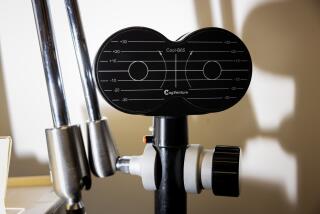Popular autism therapy mixes warm praise, firm guidance
- Share via
It’s 10:30 a.m. on a Tuesday, an hour and a half into Michael Thomson’s daily therapy. Three and a half hours left to go.
Lined up before him are three plastic blocks and a toy hippopotamus.
“Which one is different?” asks the therapist, seated on the carpet with him.
When he answers correctly,
the therapist lights up with approval: “Good job! You are so, so smart.”
The drill continues with other objects. Each correct answer allows him to add a piece to a simple wooden puzzle. Its completion entitles him to the prize of his choosing: A few minutes playing with a toy telephone.
Michael, nearly 3, has been receiving up to 29 hours a week of “applied behavior analysis,” or ABA, since he was diagnosed with autism more than a year ago. The therapy is designed to steer children away from troublesome behavior and instill social and communication skills.
Michael receives his at the Seal Beach headquarters of a company called Autism Partnership and at his home in Long Beach.
No good behavior is too insignificant for warm praise from his therapist, including peeling and eating a banana, washing his hands or using a trash can. Undesirable behavior -- sitting with limbs askew instead of cross-legged, for example -- elicits coldly delivered instructions to do better.
In some ways, ABA resembles ordinary interactions a parent has with any child. But every aspect is purposeful. Even the distance between Michael and his therapist is carefully considered -- he needs to learn to follow instructions from afar.
She won’t grant his requests unless he looks at her, and she encourages him to speak for himself rather than repeat what she says.
“I’m going to warm up by the fire,” he says as they play with pirate action figures in a plastic cave.
“You said something different,” the therapist gushes. “Michael, great thing to say.”
Later, he joins another client, 3-year-old Kate, to work on sharing and learning from each other. “Michael, pick up a piece and give it to Kate,” the therapist instructs, directing her gaze to a pile of felt cutouts.
“Here, Kate,” he says, handing her a dolphin.
When Michael fidgets and reaches for other cutouts, the therapist blocks him with her arm. “Keep your hands to yourself,” she says sternly.
Michael is one of the star patients, a quick learner with a rapidly expanding vocabulary. In January, his parents plan to place him in regular preschool. “He’s made really good, fast progress, which is so exciting,” says the therapist, Rachel Mulder, one of five who work with him.
He has improved so much that the agency that allocates state funds for ABA therapy recently downgraded his diagnosis from full-fledged autistic disorder to a milder form.
On several key measures, he now functions at close to age level, according to an August evaluation. He made eye contact, gestured appropriately, responded to his name, used a range of facial expressions and initiated social interactions with adults -- all major problems a year earlier.
Ron Leaf, a founder of the company, says the therapy transforms lives, but he would never call it a cure. “I have not a clue what we’re doing from a neurological perspective,” he said.
What is clear is that progress varies enormously from case to case, as does the therapy itself.
In another room, 51/2 -year-old Declan Byrne seems disconnected from the world. Nearly a year and a half into his intensive therapy, he disregards many instructions, plays with his eyelashes and makes humming noises.
Still, his mother, Nancy Byrne, said that he has become calmer and gone from not speaking at all to saying simple phrases such as “I want that.”
His therapy is rigid. To curb his propensity to run off, the therapist insists that he follow closely as she walks around the room. “Way to stay with me,” she says.
He struggles to complete a small puzzle and some simple tasks. The therapist encourages him to sit properly and control unusual mouth movements.
Looking over icons on an iPad screen, he chooses his reward: A scooter ride.
He propels himself down the sidewalk as his therapist jogs along. Each time she says “stop” and he obeys, he receives a gummy bear.
Eventually, he ignores her commands. She takes the scooter away, and for a moment, Declan resists walking back into the building.
Back inside, the therapist regains control. “You need to sit down,” she says, and ultimately he does.
“Nice, Declan. That’s the way to sit. You’re quiet.”
More to Read
Sign up for Essential California
The most important California stories and recommendations in your inbox every morning.
You may occasionally receive promotional content from the Los Angeles Times.










